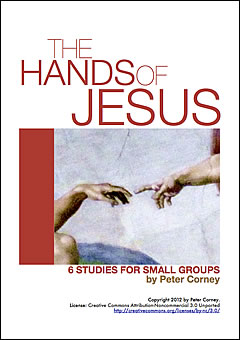
I’m very pleased to make available for free download a series of small group studies centred around the theme “The Hands of Jesus and our hands”. Accompanying the Study Booklet are six sermons, useful for preachers who wish to use the theme for a preaching series while their congregation uses the studies in small groups. The content is licensed like the rest of this website under the generous Creative Commons Attribution-Noncommercial 3.0 Unported License.
Click here to download “The Hands of Jesus – 6 Studies for Small Groups” (2MB PDF)
Click here to download the accompanying 6 sermon series focused around the theme. (2MB PDF)
Below is an excerpt from the Small Group Study Guide:
1. Hands of compassion – Matthew 8:1-17
2. Servant hands – John 13: 1-17
3. Hands that broke bread – John 21:1-14
4. Healing hands – Mark 7: 31-37
5. Hands of blessing – Mark 10;13-16, Matthew 18:1-9
6. Wounded hands – John 20:19-29
How to use these studies:
They can be used as small group study material and or combined with a sermon series; there are six accompanying sermons available for free download at http://petercorney.com. They could also be used for individual personal reflections. The Bible text is from the NIV translation.
The structure of each study:
- The theme
- An introductory question or exercise to get people thinking on the theme
- The core material of the study and Bible passages.
- Questions and exercises for group discussion
- A “take–away” task
- A thought for the week.
Introduction:
As we read the life of Jesus in the Gospels and his interactions with people one of the things that is not immediately obvious is the way he uses his hands, but when you focus on it, it is striking and suggestive. Often when he heals the sick he touches them. Although Jesus doesn’t need to touch in order to heal he often does. With his hands he washes dirty feet, he breaks and serves bread, and he cooks fish and hands it around to his disciples. He takes children into his arms and places his hands on them in blessing, and on the cross his hands are cruelly pierced. In our imagination we can also easily see Jesus warmly embracing his friends, clasping a shoulder or hand in affection or encouragement, waving a greeting or a farewell, emphasizing a point as he teaches, holding out his open hands in prayer to his Father. They are hands that are used to hard work, they are tradesman’s hands. Jesus the divine son of God is also fully human and so like us he used his hands to communicate, to express himself, to convey feelings; empathy, encouragement, support, love, friendship.
Because we use them constantly it is easy to forget how important and significant our hands are, only when we injure a finger or our hand and can not use them do we realize how much we rely on them. But they are not only critically useful to us in all our everyday tasks they are also part of our “language”, our means of expression. Our hands are used to convey a great range of messages and emotions. They are used for greetings and farewells, to express friendship, affection and love, to show praise and anger. We point in accusation, we shake a fist in anger, and we clap in appreciation and congratulation.
As disciples of Jesus we are called to follow him, he is our teacher, guide and model for the way we should live. In one of his conversations with the disciples after his resurrection and shortly before he was to leave them in body he said “As the Father has sent me so I send you”. We are now to be Jesus’ hands in the world! In these six studies we are going to focus on the way Jesus used his hands and what they tell us about the way we should live and act as his disciples.
